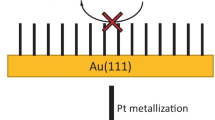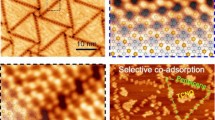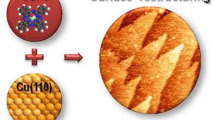Abstract
The Au (100) surface has been a subject of intense studies due to excellent catalytic activities and its model character for surface science. However, the spontaneous surface reconstruction buries active Au (100) plane and limits practical applications, and how to controllably eliminate the surface reconstruction over large scale remains challenging. Here, we experimentally and theoretically demonstrate that simple decoration of the Au (100) surface by tellurium (Te) atoms can uniquely lift its reconstruction over large scale. Scanning tunneling microscopy imaging reveals that the lifting of surface reconstruction preferentially starts from the boundaries of distinct domains and then extends progressively into the domains with the reconstruction rows perpendicular to the boundaries, leaving a Au (100)−(1 × 1) surface behind. The Au (100)−(1 × 1) is saturated at ∼ 84% ± 2% with respect to the whole surface at a Te coverage of 0.16 monolayer. With further increasing the Te coverage to 0.25 monolayer, the Au (100)−(1 × 1) surface becomes reduced and overlapped by a well-ordered (2 × 2)-Te superstructure. No similar behavior is found for Te-decorated Au (111), Cu (111), and Cu (100) surfaces, nor for the decorated Au (100) with other elements. This result may pave the way to design Au-based catalysts and, as an intermediate step, even potentially open a new route to constructing complex transition metal dichalcogenides.

Similar content being viewed by others
References
Nørskov, J. K.; Rossmeisl, J.; Logadottir, A.; Lindqvist, L.; Kitchin, J. R.; Bligaard, T.; Jónsson, H. Origin of the overpotential for oxygen reduction at a fuel-cell cathode. J. Phys. Chem. B 2004, 108, 17886–17892.
Stamenkovic, V. R.; Strmcnik, D.; Lopes, P. P.; Markovic, N. M. Energy and fuels from electrochemical interfaces. Nat. Mater. 2017, 16, 57–69.
Viswanathan, V.; Hansen, H. A.; Rossmeisl, J.; Nørskov, J. K. Universality in oxygen reduction electrocatalysis on metal surfaces. ACS Catal. 2012, 2, 1654–1660.
Štrbac, S.; Adžić, R. R. The influence of OH− chemisorption on the catalytic properties of gold single crystal surfaces for oxygen reduction in alkaline solutions. J. Electroanal. Chem. 1996, 403, 169–181.
Hammer, R.; Sander, A.; Förster, S.; Kiel, M.; Meinel, K.; Widdra, W. Surface reconstruction of Au (001): High-resolution real-space and reciprocal-space inspection. Phys. Rev. B 2014, 90, 035446.
Pieczyrak, B.; Trembulowicz, A.; Antczak, G.; Jurczyszyn, L. Nature of monovacancies on quasi-hexagonal structure of reconstructed Au (100) surface. Appl. Surf. Sci. 2017, 407, 345–352.
Ercolessi, F.; Tosatti, E.; Parrinello, M. Au (100) surface reconstruction. Phys. Rev. Lett. 1986, 57, 719–722.
Magnussen, O. M.; Hotlos, J.; Behm, R. J.; Batina, N.; Kolb, D. M. An in-situ scanning tunneling microscopy study of electrochemically induced “hex” ↔ (1 × 1) transitions on Au (100) electrodes. Surf. Sci. 1993, 296, 310–332.
Trembulowicz, A.; Pieczyrak, B.; Jurczyszyn, L.; Antczak, G. Coexistence of nanowire-like hex and (1 × 1) phases in the topmost layer of Au (100) surface. Nanotechnology 2019, 30, 045704.
Tempas, C. D.; Skomski, D.; Tait, S. L. Lifting of the Au (100) surface reconstruction by Pt, Cr, Fe, and Cu adsorption. Surf. Sci. 2016, 654, 33–38.
Hernán, O. S.; De Parga, A. L. V.; Gallego, J. M.; Miranda, R. Self-surfactant effect on Fe/Au (100): Place exchange plus Au self-diffusion. Surf. Sci. 1998, 415, 106–121.
Zhang, E. W.; Lin, F. R.; Lei, Z. H.; Qi, S.; Ban, S. Y.; Vinu, A.; Yi, J. B.; Liu, Y. P. Twist the doorknob to open the electronic properties of graphene-based van der Waals structure. Matter 2021, 4, 3444–3482.
Jiang, Y.; Liang, X. H.; Ren, S. D.; Chen, C. L.; Fan, L.; Yang, Y. W.; Tang, J. M.; Luh, D. A. The growth of sulfur adlayers on Au (100). J. Chem. Phys. 2015, 142, 064708.
Ikemiya, N.; Iwai, D.; Yamada, K.; Vidu, R.; Hara, S. Atomic structures and growth morphologies of electrodeposited Te film on Au (100) and Au (111) observed by in situ atomic force microscopy. Surf. Sci. 1996, 369, 199–208.
Sorenson, T. A.; Suggs, D. W.; Nandhakumar, I.; Stickney, J. L. Phase transitions in the electrodeposition of tellurium atomic layers on Au (100). J. Electroanal. Chem. 1999, 467, 270–281.
Sorenson, T. A.; Lister, T. E.; Huang, B. M.; Stickney, J. L. A comparison of atomic layers formed by electrodeposition of selenium and tellurium scanning tunneling microscopy studies on Au (100) and Au (111). J. Electrochem. Soc. 1999, 146, 1019–1027.
Cheng, F.; Xu, H.; Xu, W. T.; Zhou, P. J.; Martin, J.; Loh, K. P. Controlled growth of 1D MoSe2 nanoribbons with spatially modulated edge states. Nano Lett. 2017, 17, 1116–1120.
Cheng, F.; Hu, Z. X.; Xu, H.; Shao, Y.; Su, J.; Chen, Z.; Ji, W.; Loh, K. P. Interface engineering of Au (111) for the growth of 1T′-MoSe2. ACS Nano 2019, 13, 2316–2323.
Comin, F.; Citrin, P. H.; Eisenberger, P.; Rowe, J. E. Unusual chemisorption behavior of Te on Cu {111} versus Cu {100}. Phys. Rev. B 1982, 26, 7060–7062.
Lahti, M.; Chaudhuri, A.; Pussi, K.; Hesp, D.; McLeod, I. M.; Dhanak, V. R.; King, M. O.; Kadodwala, M.; Maclaren, D. A. The structural analysis of Cu (111)-Te \((\sqrt 3 \times \sqrt 3 ){\rm{R}}{30^\circ }\) and \((2\sqrt 3 \times 2\sqrt 3 ){\rm{R}}{30^\circ }\) surface phases by quantitative LEED and DFT. Surf. Sci. 2014, 622, 35–43.
Hasegawa, Y.; Avouris, P. Manipulation of the reconstruction of the Au (111) surface with the STM. Science 1992, 258, 1763–1765.
Bartelt, N. C.; Thürmer, K. Structure and energetics of the elbows in the Au (111) herringbone reconstruction. Phys. Rev. B 2021, 104, 165425.
Liu, Y. P.; Qiu, Z. Z.; Carvalho, A.; Bao, Y.; Xu, H.; Tan, S. J. R.; Liu, W.; Neto, A. H. C.; Loh, K. P.; Lu, J. Gate-tunable giant stark effect in few-layer black phosphorus. Nano Lett. 2017, 17, 1970–1977.
Liu, Y. P.; Rodrigues, J. N. B.; Luo, Y. Z.; Li, L. J.; Carvalho, A.; Yang, M.; Laksono, E.; Lu, J. P.; Bao, Y.; Xu, H. et al. Tailoring sample-wide pseudo-magnetic fields on a graphene-black phosphorus heterostructure. Nat. Nanotechnol. 2018, 13, 828–834.
Horcas, I.; Fernández, R.; Gómez-Rodríguez, J. M.; Colchero, J.; Gómez-Herrero, J.; Baro, A. M. WSXM: A software for scanning probe microscopy and a tool for nanotechnology. Rev. Sci. Instrum. 2007, 78, 013705.
Kresse, G.; Hafner, J. Ab initio molecular dynamics for liquid metals. Phys. Rev. B 1993, 47, 558–561.
Kresse, G.; Hafner, J. Ab initio molecular-dynamics simulation of the liquid-metal-amorphous-semiconductor transition in germanium. Phys. Rev. B 1994, 49, 14251–14269.
Kresse, G.; Furthmüller, J. Efficiency of ab-initio total energy calculations for metals and semiconductors using a plane-wave basis set. Comput. Mater. Sci. 1996, 6, 15–50.
Kresse, G.; Furthmüller, J. Efficient iterative schemes for ab initio total-energy calculations using a plane-wave basis set. Phys. Rev. B 1996, 54, 11169–11186.
Kresse, G.; Joubert, D. From ultrasoft pseudopotentials to the projector augmented-wave method. Phys. Rev. B 1999, 59, 1758–1775.
Blöchl, P. E. Projector augmented-wave method. Phys. Rev. B 1994, 50, 17953–17979.
Perdew, J. P.; Burke, K.; Ernzerhof, M. Generalized gradient approximation made simple. Phys. Rev. Lett. 1996, 77, 3865–3868.
Davidson, E. R. Matrix eigenvector methods. In Methods in Computational Molecular Physics; Diercksen, G. H. F.; Wilson, S., Eds.; Springer: Dordrecht, 1983; pp 95–113.
Tersoff, J.; Hamann, D. R. Theory of the scanning tunneling microscope. Phys. Rev. B 1985, 31, 805–813.
Vanpoucke, D. E. P.; Brocks, G. Formation of Pt-induced Ge atomic nanowires on Pt/Ge (001): A density functional theory study. Phys. Rev. B 2008, 77, 241308.
Momma, K.; Izumi, F. VESTA 3 for three-dimensional visualization of crystal, volumetric and morphology data. J. Appl. Crystallogr. 2011, 44, 1272–1276.
Jones, R. O.; Gunnarsson, O. The density functional formalism, its applications and prospects. Rev. Mod. Phys. 1989, 61, 689–746.
Zhang, T. H.; Anderson, A. B. Oxygen reduction on platinum electrodes in base: Theoretical study. Electrochim. Acta 2007, 53, 982–989.
Tarasevich, M. R.; Sadkowski, A.; Yeager, E. Oxygen electrochemistry. In Comprehensive Treatise of Electrochemistry: Volume 7 Kinetics and Mechanisms of Electrode Processes; Conway, B. E.; Bockris, J. O. M.; Yeager, E.; Khan, S. U. M.; White, R. E., Eds.; Springer: Boston, 1983; pp 301–398.
Acknowledgements
The authors wish to acknowledge the financial support provided by the National Natural Science Foundation of China (No. 1210040808), the Natural Science Foundation of Jiangsu Province (Nos. BK20210312 and BK20212008), the National Key Research and Development Program of China (No. 2019YFA0705400), the Fundamental Research Funds for the Central Universities (Nos. NJ2022002, NZ2020001, and NS2022014), the Program for Innovative Talents and Entrepreneur in Jiangsu, Research Fund of State Key Laboratory of Mechanics and Control of Mechanical Structures (Nos. MCMS-I-0419G02 and MCMS-I-0421K01), and a project funded by the Priority Academic Program Development of Jiangsu Higher Education Institutions.
Author information
Authors and Affiliations
Corresponding authors
Electronic Supplementary Material
Rights and permissions
About this article
Cite this article
Zhang, E., Lu, H., Zhang, W. et al. Lifting surface reconstruction of Au (100) by tellurium adsorption. Nano Res. 16, 6967–6973 (2023). https://doi.org/10.1007/s12274-023-5461-0
Received:
Revised:
Accepted:
Published:
Issue Date:
DOI: https://doi.org/10.1007/s12274-023-5461-0




